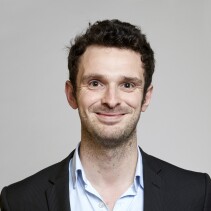Address:
School of Physical and Chemical Sciences
University of Canterbury
Private Bag 4800
Christchurch 8140
Biography
Tom was born in South Shields, in the North-East of England, in 1986. He read the Natural Sciences Tripos at the University of Cambridge, specialising in Chemistry and gaining a 1st class MSci (Hons) in 2008. He then moved across to the Materials Science and Metallurgy Department, to study the physical properties of porous hybrid frameworks under Professor Anthony Cheetham FRS.
A three-year Research Fellowship at Trinity Hall, University of Cambridge, followed, alongside lecturing some of the 1B Materials Chemistry course at the department. He started a Royal Society University Research Fellowship in 2016, along with a visiting adjunct professor position at the Wuhan University of Technology and a visiting scientist position at CSIRO Melbourne. The research group is best known for the discovery of hybrid melt-quenched glasses, and seminal works exploring the interface of the coordination polymer, MOF and glass domains. The group have considerable expertise in the characterisation of amorphous solids and liquids, and in creating new classes of functional material. For a taste of the research performed by the group, have a look at Tom’s plenary lecture at the International MOF Conference in 2022 here.
In his career to date, Tom has been fortunate enough to receive the EPSRC post-doctoral prize (2012), the Panalytical award for an outstanding contribution to X-ray diffraction (2013), the ISIS Neutron and Muon Source Science Impact Award (2018), the Woldemar A. Weyl award for glass science (2019), the Philip Leverhulme Prize in Chemistry (2019), the Royal Society of Chemistry Harrison Meldola Memorial Prize (2020), the Chemical Communications Lectureship (2022) and the Gottardi Award (2024).
He has spent research stays in both the University of Kyoto (hosted by Professor Susumu Kitagawa and Professor Satoshi Horike), the University of Canterbury, New Zealand (hosted by Professor Paul Kruger), and the Friedrich Schiller University Jena (hosted by Professor Dr Lothar Wondraczek). He has served as both vice-Chair of the International Zeolite Association Commission on MOFs (2019 – 2022), and inaugural chair of the Royal Society of Chemistry Interest Group on Porous Materials (2019-2022). The committee were awarded the inspirational committee award by the Royal Society of Chemistry in 2021. This was for admitting over 300 members as the RSC’s newest interest group, and organisation of events during the COVID-19 pandemic. He was promoted to Professor in 2023, and joined the University of Canterbury, New Zealand, in 2024.
Tom loves photography, hiking and river crossings. In his spare time, he can often be found camping with his energetic dog, Albie, which is a Springer-Collie cross.
Research interests
Tom's research interests revolve primarily around the creation of new, and characterisation of existing, disordered materials.
Glasses are ‘frozen liquids’, formerly thought to belong to three categories: inorganic, organic or metallic. The most common route to the glassy state involves melt-quenching, i.e. cooling a liquid on a timescale fast enough to avoid molecular or atomic reordering to an ordered state. On heating, glasses undergo a reversible transition to a softer, more liquid-like state at their glass transition temperature (Tg). Despite the enormous number (>80,000) of crystalline hybrid solids such as MOFs and HOIPs known, their disordered states remain almost totally unknown. This group have pioneered the synthesis and characterisation of glasses formed by melting hybrid solids. For example, the melt-quenching of several zeolitic imidazolate frameworks results in glasses which retain the metal-organic-metal connectivity of the crystalline state, though are bulk, transparent, grain-boundary free materials. Equally, we have also shown that hybrid perovskite materials are also glass formers, and that the glasses display interesting thermoelectric properties. The glasses belong to the family of hybrid glasses – a new 4th category of glass, Their structural, mechanical, chemical and optical properties are thus of extreme interest, and the group works on building structure-property relationships so that we can design the next generation of functional glass.
The work on hybrid glasses is based on cutting edge characterisation techniques, and crosses supramolecular chemistry, structural chemistry, condensed matter physics and mechanical properties domains. Tom is also interested in:
- The mechanical properties of crystalline materials
- The formation and characterisation of photoactive glasses from hybrid perovskites, for use in solar cell technologies
- Identity and structure of amorphous waste products
- Identity and structure of complex environmental contaminants
The most interesting areas of science to me are those between fields. The trick is to creating them is to be open to learning in unfamiliar areas.
Professor Tom Bennett



